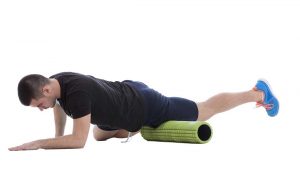If you use a foam roller or are interested in starting, this article provides an overview of what scientific research tells us about the benefits.
The use of foam rolling is associated with many different claims, including improved flexibility and joint range of motion, faster recovery from workouts and injuries, improved circulation (along with reduced arterial stiffness and better vascular function), reduced muscle tightness, faster healing from soft-tissue injury, and reduced adhesions and scar tissue.
Foam rolling is often referred to as a self-myofascial release technique, akin to deep-tissue massage and soft-tissue mobilization such as the Graston Technique®. The general idea is that manipulating the skin, muscle, and surrounding connective tissue, especially the fascia overlying muscles, helps free up stiff, tight, sore muscles. Fascia is a sheet or band of fibrous connective tissue. One layer of fascia lies in the lowermost boundary of the skin, while other sheets of fascia sheath and separate muscles. Fascia also surrounds organs such as the heart, liver, and lungs to keep them supported yet able to shift their positions as our bodies move. In short, fascia is a supportive, yet movable, flexible wrap that reduces friction between contracting muscle groups, as well as performing similar functions for blood vessels, nerves, and organs. In theory, if fascia movement becomes restricted, muscle function can be impeded.
The mechanisms by which foam rolling might confer its benefits are not well understood but might include changes in how the nervous system provides input to resting muscles or in structural changes in the fascia that reduce its stiffness and improve how fascia slides over muscles.
Research on the benefits of foam rolling is relatively new, so there are not a lot of studies from which to draw a conclusion. As in all areas of science, some studies show benefits, while others do not. However, some thorough studies have reported measurable benefits. For example, subjects who performed 20 minutes of foam rolling immediately after and again one and two days after completing 10 sets of 10 weighted squats reported less muscle soreness and had better range of motion and measures of muscle activation compared to a group of matched subjects who did the same squat routine but no foam rolling (MacDonald et al. 2014). The same group of researchers confirmed that 20 minutes of foam rolling reduced quadricep tenderness and improved 30-meter sprint performance in the days after subjects completed the 10 x 10 squat routine compared to the responses of subjects who did no foam rolling (Pearcey et al. 2015). Another study showed greater hip-flexion range of motion when the subjects combined foam rolling with a static-stretch routine compared with static stretching or foam rolling alone (Mohr et al. 2014). As more research is conducted and published, the specific benefits of foam rolling—and the magnitude and duration of those benefits—will become clearer.
In summary, evidence is accumulating in support of foam rolling to reduce post-exercise muscle soreness, increase joint range of motion—at least in the short-term (Su et al. 2016) -- and to help preserve muscle function and performance following tough workouts. If foam rolling is part of your training routine, there is certainly no reason to stop and some emerging reasons to continue. If you are using foam rolling to rehab from an injury, take care not to aggravate the injury or ignore other forms of treatment if pain and weakness continue.
Foam rolling is an example of a new recovery modality that athletes are putting to good use. Some athletes are also finding that HOTSHOT helps them recover more quickly. In fact, pro fullback James Develin, uses HOTSHOT to set his body on track for recovering for the next workout and big game.
References
- MacDonald GZ, DC Button, EJ Drinkwater, DG Behm. Foam rolling as a recovery tool after an intense bout of physical activity. Med Sci Sports Exerc 46(1):131-42, 2014.
- Mohr AR et al. Effect of foam rolling and static stretching on passive hip-flexion range of motion. J Sport Rehabil 23(4):296-299, 2014.
- Pearcey GEP et al. Foam rolling for delayed-onset muscle soreness and recovery of dynamic performance measures. J Athl Train 50(1):5-13, 2015.
- Su H et al. Acute effects of foam rolling, static stretching, and dynamic stretching during warm-ups on muscular flexibility and strength in young adults. J Sport Rehabil 13:1-24, 2016.

